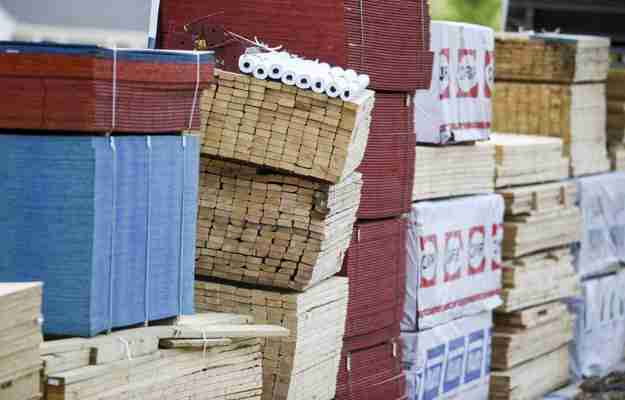April 09,2022
Why Lumber And Plywood Prices Are So High—And When They Will Come Down
by David Stewart
Lumber, plywood and other building materials at a Forino Builders construction site in Lower ... [+] Heidelberg Township. (Photo by Ben Hasty/MediaNews Group/Reading Eagle via Getty Images) MediaNews Group via Getty Images

Lumber and plywood prices have jumped through the roof in the U.S. Building materials prices will retreat in 2022, returning to pre-pandemic levels by 2023. They reflect housing-specific issues, not general inflation. (The general inflation is coming, I have argued, but lumber is not an early sign.)
Wood products prices typically fluctuate more than most goods, because homebuilding can move up or down much faster than sawmill capacity can. Wood products have other uses that are more stable, such as non-residential construction, crates and pallets, but new housing is the largest usage, followed by home repairs and remodeling, and both of those activities are highly cyclical.
Wood is fairly abundant, in North America, especially in the southern forests. Modern mills are very efficient at turning logs into 2x4s and sheets of plywood. Lumber and plywood prices are so high now because of the short-run dynamics of demand and supply.
Wood demand shot up in the summer of pandemic. Many homeowners were stuck at home, unable to vacation. With time and money on their hands, they headed to the local building supplies dealer for the materials to build decks, playhouses, she-sheds and even additional rooms.
Then in the autumn of 2020, homebuilders cranked up their construction. By December, single family housing starts (seasonally adjusted) hit their highest level since 2006. This activity was driven by cheap mortgages.
All interest rates dropped in the early days of the pandemic. Mortgage rates fell at a slower pace, but eventually 30-year fixed-rate mortgages dropped under three percent, hitting all-time record lows.
The low mortgage rates brought more buyers into the single family real estate market. Working remotely persuaded a few long-time apartment dwellers to buy houses, but the huge impact came from families that had anticipated buying a house in a few years. With extremely low mortgage rates, purchases penciled out in 2020 and 2021.
Wood products companies would like to add capacity, but a new mill takes about two years to build. Before the pandemic, many new mills were being built as production shifted from Canada to the South. (The Financial Post reported, “A plague of tiny mountain pine beetles, no bigger than a grain of rice, has already destroyed 15 years of log supplies in British Columbia, enough trees to build 9 million single-family homes, and are chewing through forests in Alberta and the Pacific Northwest.”) The construction of the new southern mills begun in 2018 and 2019 led to long lead times for mill equipment. Thus, building a new mill today would probably take more than two years.
Producers are trying to increase the output of existing mills, but labor is a challenge for most of them. A few Covid-19 outbreaks among production workers have disrupted production. Mills also have difficulty hiring new workers. There has been a long-term trend away from blue collar occupations, partly a result of educators telling high school students they have to go to college. On top of that, mills are usually located in rural communities that have been losing population. Finally, the stimulus checks and unemployment insurance bonus payments have sapped some people’s interest in taking jobs.
On top of the direct labor challenges, truck drivers are vital to production, starting with moving logs from forests to mills and then getting finished products to distribution centers and lumber yards. Truck drivers are in short supply across the economy. Glue shortages, caused by the storm-related shutdown of petrochemical plants in Texas, also lowered plywood production, but that’s a temporary problem.
These constraints mean that increased supply won’t bring prices down any time soon. It also explains why prices rose so sharply in the past year.
Lumber and plywood prices will drop as demand falls. At some point, most of the people who can take advantage of low mortgage rates will already have bought a house. And interest rates will eventually rise. (I predict mortgage rates will rise in the later months of 2021 and more rapidly throughout 2022, but my fellow economists see more muted increases.) By the end of 2023, the strong increase in demand for housing will be over. At that point, lumber and plywood sales will drop to more normal levels.
Some wood products executives see recent demand as a return to normal, rather than abnormally high. Housing starts averaged 1.5 million units per year from 1960 through 2010, but the last decade has been below that benchmark. That reasoning fails to consider population growth, the largest driver of housing demand. Over that earlier time period, population growth averaged 1.1% per year. Over the past decade, however, our population growth was just 0.6%. In the 1960-2010 era, the number of households grew by 1.3 million per year. In the last decade, growth averaged only 1.1 million households. And population growth has slowed more in recent years because of very low immigration. With lower growth of population and households, the historical 1.5 million housing starts is reasonable as a boom year, not an average.
Lumber and plywood prices typically rise in the spring and drop by the end of fall, by about five percent. This year look for not a decline but a leveling off. Prices will remain high for another two or three years, then drop back to more normal levels. The key to the pace of decline will be mortgage rates. In the meantime, homebuilders will pass the costs along to their buyers. The do-it-yourselfers will have a good excuse to postpone new projects. What better time to take a vacation?






